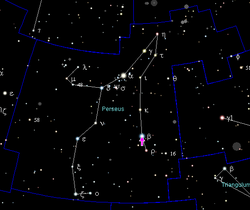Algol
2007 Schools Wikipedia Selection. Related subjects: Space (Astronomy)
| Observation data Epoch J2000 |
|
|---|---|
| Constellation | Perseus |
| Right ascension | 03h 08m 10.1315s |
| Declination | +40° 57′ 20.332″ |
| Apparent magnitude (V) | 2.12 |
| Characteristics | |
| Spectral type | B8V/K02IV/A5V |
| B-V colour index | -0.05 |
| U-B colour index | -0.37 |
| Variable type | Eclipsing binary |
| Astrometry | |
| Radial velocity (Rv) | 3.7 km/s |
| Proper motion (μ) | RA: 2.39 mas/ yr Dec.: -1.44 mas/ yr |
| Parallax (π) | 35.14 ± 0.90 mas |
| Distance | 93 ± 2 ly (28.5 ± 0.7 pc) |
| Absolute magnitude (MV) | -0.15 |
| Details | |
| Mass | 3.59/0.79/1.67 M☉ |
| Radius | 2.3/3.0/0.9 R☉ |
| Luminosity | 98/3.4/4.1 L☉ |
| Temperature | 12,000/4,500/8,500 K |
| Metallicity | Not available |
| Rotation | 65 km/s. |
| Age | < 3 × 108 years |
| Other designations | |
|
Algol, Gorgona, Gorgonea Prima, Demon Star, El Ghoul, 26 Per, GJ 9110, HR 936, BD +40°673, HD 19356, GCTP 646.00, SAO 38592, FK5 111, Wo 9110, ADS 2362, WDS 03082+4057A, HIP 14576.
|
|
Algol (β Per / Beta Persei) is a bright star in the constellation Perseus. It is one of the best known eclipsing binaries, the first such star to be discovered, and also one of the first (non- nova) variable stars to be discovered. Algol's magnitude changes regularly between 2.1 and 3.4 over a period of 2 days, 20 hours and 49 minutes.
History
The name Algol means "demon star," (from Arabic الغول al-ghūl, "the ghoul") which was probably given due to its peculiar behaviour. In the constellation Perseus, it represents the eye of the Gorgon Medusa.
It is known as 大陵五 (the Fifth Star of the Mausoleum) in Chinese.
Astrologically, Algol is considered the most unfortunate star in the sky. In the Middle Ages it was one of the 15 Behenian stars, associated with the diamond and hellebore, and marked with the kabbalistic sign ![]() .
.
The variability of Algol was first recorded in 1667 by Geminiano Montanari, but it is probable that this property was noticed long before this time. The first person to propose a mechanism for the variability of this star was the British amateur astronomer John Goodricke. In May, 1783 he presented his findings to the Royal Society, suggesting that the periodic variability was caused by a dark body passing in front of the star (or else that the star itself has a darker region that is periodically turned toward the Earth.) For his report he was awarded the Copley Medal.
In 1881, the Harvard astronomer Edward Pickering presented evidence that Algol was actually an eclipsing binary. This was confirmed a few years later, in 1889, when the Potsdam astronomer Hermann Vogel found periodic doppler shifts in the spectrum of Algol, infering variations in the radial velocity of this binary system. Thus Algol became one of the first known spectroscopic binaries.
Star system
As an eclipsing binary, it is actually two stars in close orbit around one another. Because the orbital plane coincidentally contains the Earth's line of sight, the dimmer star (Algol B) passes in front of the brighter star (Algol A) once per orbit, and the amount of light reaching Earth is temporarily decreased. To be more precise, however, Algol happens to be a triple star system: the eclipsing binary pair is separated by only 0.062 AU, while the third star (Algol C) is at an average distance of 2.69 AU from the pair and the mutual orbital period is 681 days (1.86 years). The total mass of the system is about 5.8 solar masses, and the mass ratios of A, B and C are about 4.5 : 1 : 2.
| Components | Semimajor axis | Ellipticity | Period | Inclination |
|---|---|---|---|---|
| A—B | 0.00218″ | 0.00 | 2.87 days | 97.69° |
| (AB)—C | 0.09461″ | 0.225 | 680.05 days | 83.98° |
Studies of Algol led to the Algol paradox in the theory of stellar evolution: although components of a binary star form at the same time, and massive stars evolve much faster than the less massive ones, it was observed that the more massive component Algol A is still in the main sequence, while the less massive Algol B is a subgiant star at a later evolutionary stage. The paradox can be solved by mass transfer: when the more massive star became a subgiant, it filled its Roche lobe, and most of the mass was transferred to the other star, which is still in the main sequence. In some binaries similar to Algol, a gas flow can actually be seen.
This system also exhibits variable activity in the form of x-ray and radio flares. The former is thought to be caused by the magnetic fields of the AB components interacting with the mass transfer. The radio emissions may be created by magnetic cycles similar to sunspots, but, as the magnetic fields around these stars are up to ten times stronger than that of the Sun, these radio flares are more powerful and longer lasting.
Algol is 92.8 light years from Earth; however, about 7.3 million years ago it passed within 9.8 light years and its apparent magnitude was approximately −2.5, considerably brighter than Sirius is today. Because the total mass of the system is 5.8 solar masses, and despite the fairly large distance at closest approach, this may have been enough to slightly perturb the solar system's Oort cloud and increase the number of comets entering the inner solar system. However, the actual increase in net cratering rate is believed to have been quite small.
